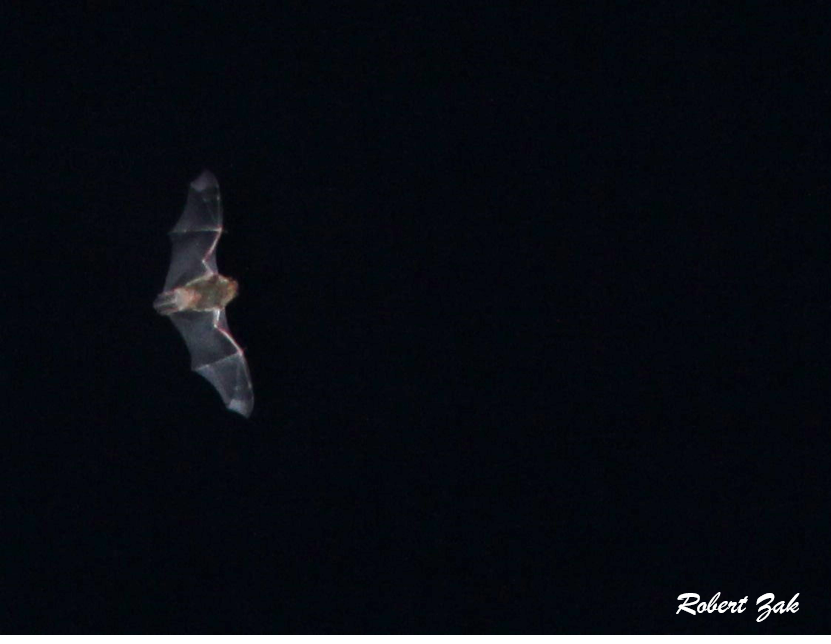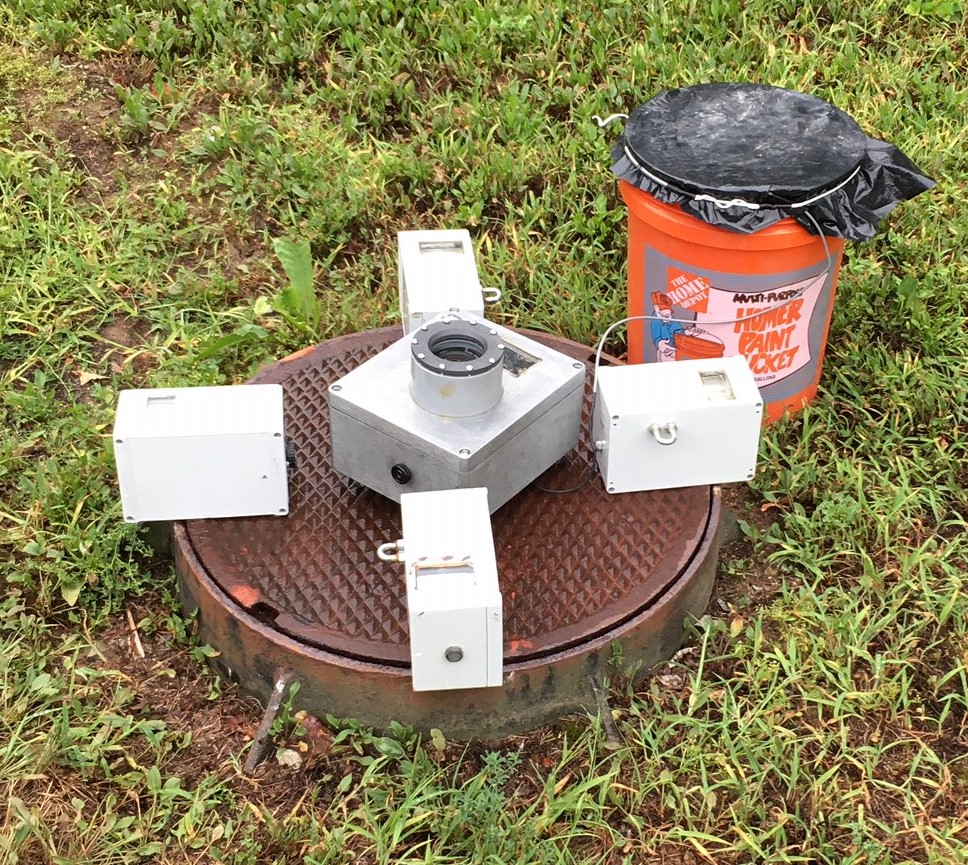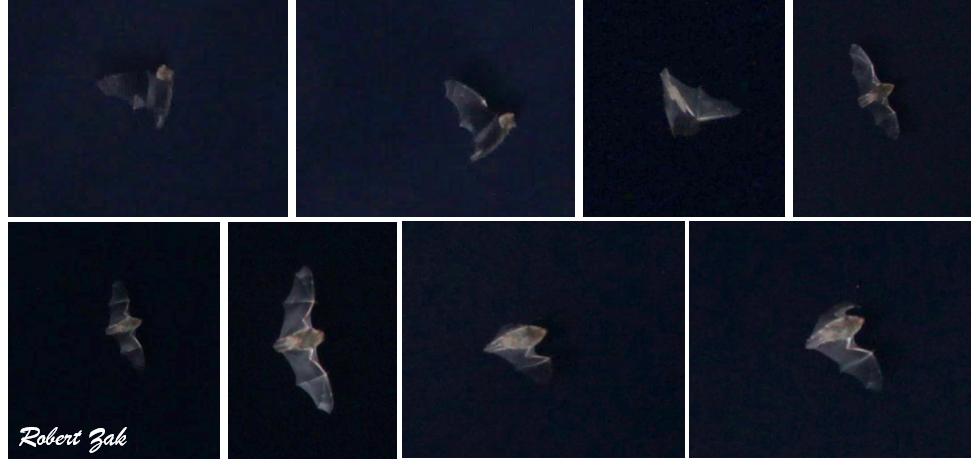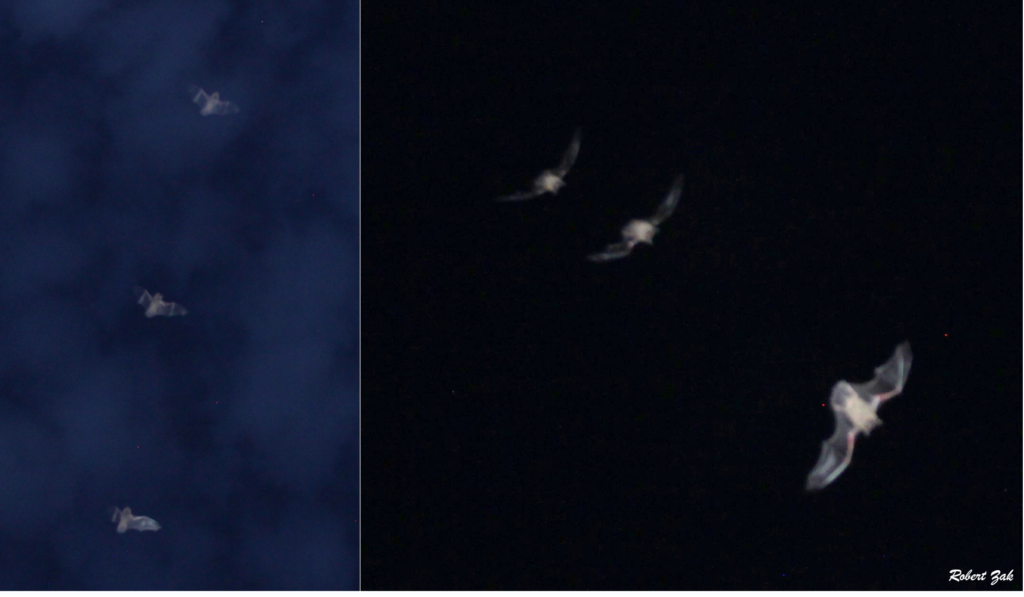Camera Trapping Bats with an Acoustic Trigger

Camera trapping bats is deceptively hard. Bats are such small infrared targets that they are seldom detected by the PIR sensors that trigger standard trail cameras. In contrast, almost all bats produce intense ultrasonic sounds for echolocation. These sounds can be detected by an acoustic sensor, which can then be used as the basis for an acoustic trigger for a camera. In this first post on bats, I describe a camera trap setup with an acoustic sensor and trigger I used to get photos, like the one above, with a DSLR setup. I did this work right in our backyard, where bats consistently hunted during the summer. This gave me easy access to the setup, and allowed me to try and test new ideas and to tune the set.
As with any camera trapping, the welfare of the target species is a priority. There may be restrictions on photographing bats in your area, including using the setup I describe in this post. I have updated this post recently with additions to “Bat Photography Restrictions” (formerly “Disclaimers”) and “References”.
Bat Species in Massachusetts
Not knowing a lot about the bats in our area, I did some research to get an idea of the local species, their prevalence, feeding behavior, and winter roosting sites. Eventually, I’d like to identify the species of bats we photograph, though that will have to wait for a future post.
According to Mass.gov, there are 9 species of bats found in Massachusetts. These are described in table below:
| Common Name | Scientific Name | Status | MA Range | Summer Roost | Winter Roost | Food Source |
| Big Brown Bat | Eptesicus fuscus | Common | Statewide | Buildings, trees | Buildings, caves, mines | Insects, including hard-bodied beetles |
| Silver-Haired Bat | Lasionycteris noctivagans | Common | Probably Statewide | Trees, rock crevices | Buildings, trees (migratory) | Soft-bodied insects (moths) |
| Eastern Red Bat | Lasiurus borealis | Common | Statewide | Tree foliage | Migratory | Soft-bodied insects (moths) |
| Hoary Bat | Lasiurus cinereus | Common | Statewide | Tree foliage | Migratory | Soft-bodied insects (moths) |
| Little Brown Bat | Myotis lucifugus | MA: Endangered | Statewide | Buildings | Caves, mines | Arthropods, including hard-bodied insects |
| Northern Long-eared Bat | Myotis septentrionalis | MA: Endangered | Statewide | Trees, Building Exteriors | Caves, mines | Insects, primarily moths, gleaned from surfaces |
| Indiana Bat | Myotis sodalis | MA: Endangered | Berkshire and Hampden Counties | Caves, mines, hollow trees, under bark | Caves, mines | Insects, including hard-bodied beetles, moths, and mosquitos |
| Eastern Small-footed Bat | Myotis leibii | MA: Endangered | Berkshire and Hampden Counties | Under bark, in rock talus and deep fissures | Caves, mines | Flying insects |
| Tricolored Bat | Perimyotis subflavus | MA: Endangered | Statewide | Trees (rarely in buildings) | Caves, mines, rock crevices | Flying insects |
The most likely bats for us to find in our backyard are the first four in this list: Big Brown, Silver-Haired, Eastern Red, and Hoary. These are all listed as common in Massachusetts and range over the entire state. Other species, especially the once common Little Brown and Tri-colored bats, are now locally endangered. This due to the recent impact of lethal fungi (e.g. White Nose) infecting their winter roosting spots — caves and mines. Importantly, all of the species in Massachusetts are insect-eating, which makes them harder to camera trap than some of the nectar feeding species found elsewhere.
Camera Trapping Bats
There are several excellent remote camera photos of bats online. I have included a sampling in the reference list at the end of the post. Obtaining these photos tends to rely on techniques such as:
- targeting a nectar feeding species and setting up camera near a favorite nectar source
- finding and placing a camera near the roosting site of a colony
- placing camera near a a water source where bats come to drink, or where insects fly about
Since our bats are insectivores, don’t nest in colonies near our yard, and go elsewhere to drink, I decided to focus my back-yard efforts on capturing our bats in mid-hunt.
DSLR Camera Trap with Acoustic Trigger
Although bats are hard to detect with a PIR sensor, since they emit intense ultrasonic sounds for echolocation, they are relatively easy to detect with an acoustic sensor. Although we can’t hear bat sounds directly, a suitable acoustic sensor can do so easily. I used a commercially available acoustic sensor to detect bats and to trigger a customized DSLR trail camera setup. Specifically:
- An acoustic bat sensor: I used the “Belfry Bat Detector” (See references) with both LED and speaker jack options. Though the technology is somewhat dated, I found it reliably triggered in the presence of bats. Critically, I also found it to be immune to false triggers due to the non-bat cacophony which summer nights bring to central Massachusetts.
- A PicAxe microcontroller with a custom program and circuits to shift the signal level from the input from the bat detector and to drive the shutter release on the camera. For the multi-exposure photos, I also connected the PicAxe controller directly to a PixelSoldier transmitter to trigger the remote flashes.
- A Canon60D DSLR with remote shutter release and PixelSoldier transmitter for remote flashes
- 4 Nikon SB-28 xenon flash units with Pixel Soldier wireless receivers
Below is a photo of the setup placed on the manhole cover over our septic pump in our front yard. We were getting dew in the morning, and an occasional thunderstorm, so everything needed moisture protection. The camera and the flashes have custom, waterproof housings which I made previously for general camera trapping duty (see: Building a DSLR Camera Trap: Part 1 – Design Elements). I placed the bat detector and the PicAxe controller in a plastic bucket covered by a plastic sheet stretched across the top with a spring-loaded band. This kept the water out, but allowed the bat sounds through.

A Collection of Bats
Over multiple nights, we went to sleep with the occasional lights from the flashes in the front yard lighting up our bedroom like a quiet thunderstorm. Here are a few of the other photos I found:

Capturing Flight Patterns with Multi-Exposure Shots
Inspired by the bat photographs of Paul Colley (see references), I decided to try to get photographs that would better capture the bats’ acrobatic flight. The setup looks like the one above, but I modified the PicAxe controller to create independent signals to the camera shutter release and to the flashes. Keeping the shutter open through multiple flashes allowed me to capture multiple images of a single bat as it flew across the field of view. For setup details, see the appendix, below.
Below are a couple of photos I made using this setup.

Looking Ahead to Spring
Although the acoustic trigger featured in this post worked well, the resulting photos are less than ideal. At typical overflight heights, the bats are too far from the camera to get good lighting, and too small in the field to get a high resolution image. This even with an array of xenon flashes, and a DSLR camera.
One hardly needs another reason to look forward to spring, but we’ve now added to our list: the return of bats. In the coming spring, we plan to work harder to attract the bats closer to the camera. With it’s wealth of insects, our vegetable garden is one possible draw. As is a bat house, or a reliable water source, like a bird (bat) bath.
In the meantime, if you have had success capturing bat photos with an acoustic trigger, or any other technique, please let me know in comments below.
Bat Photography Restrictions
In my original post on this topic, I noted that the UK restricts bat photography using visible flashes. This would clearly preclude the setup I described in this post from being used in the UK. One of our UK followers pointed out other restrictions in the UK and EU, including requiring a license for bat photography. It is clear different jurisdictions may place restrictions on wildlife photography aimed at protecting the habitats, nesting areas, and feeding activities of protected species. Please be aware of, and work within any local resctrictions. I have added some examples, specifically from the UK, to the references below. If you are aware of others, please feel free to add to comments.
Appendix A: Single-Exposure Configuration Details
I set the flashes to 1/4 power; and the camera to a 24, 35, and 55 mm focal lengths, and aperture to F 5.6, ISO to 640, shutter speed 1/100 second. Using 4 flashes allowed me to lower the power on each, which reduces the recovery time required between flashes.
I programmed the PicAxe controller to activate the shutter release for a burst of 3 photos when it detected a signal from the acoustic trigger, then to wait 5 seconds before “rearming” itself again to allow flashes to recover.
I used a 18-55 mm telephoto lens, and tried different focal lengths within this range. At 24 mm, the field of view is larger, so I got many photos of bats; but the bats were quite small in the frame. Zooming in to 35mm reduced the field of view, and therefore the number of photographs with bats, but the bats were larger and clearer in the field. I found the field of view at 55 mm to be so small as to miss almost all of the bats.
Using a 35 mm lens, I typically got a couple of hundred “triggers” per night. Of those, about 10-20% had any bat at all in them. Of the photos with bats, only 10% of these were clear enough to be at all useful.
Appendix B: Multi-exposure Configuration Details
I set the camera in “Bulb” mode — which causes the shutter on the camera to remain open as long as the shutter release is active. Finally, I edited the PicAxe program so that on every acoustic trigger, the controller:
- Activates the shutter release, opening the camera shutter
- Activiates the flashes in a quick series of pulses
- De-activates the shutter release
I spent several nights tuning parameters, and finally ended up the controller operating the flashes with a 50 ms pulse, with each pulse is separated by 75 ms — so a flash every 125 ms, or a rate of 8 flashes per second. The SB28s at 1/4 intensity can handle bursts of up to 4 or 5 flashes, so I set the “flash burst length” to 4, which gives a total exposure time of just over a half a second.
Appendix C: Finding Focus
One of the challenges was focusing the camera. The optical auto-focus won’t work, since there is not enough light. If there were, the autofocus would be unlikely to be able to find the bat in the field of view, or react quickly enough to take a picture. Manual focus is required. I took photos of a scale drawing of a generic bat with a 12″ wingspan at various distances. Then I compared these to the (originally very fuzzy) silhouettes I captured, and determined the distance ranged between 30 and 60 feet.
Next, I used a an online Depth of Field calculator (see references). For a given focal length, I used the calculator to find the largest possible aperture setting (lowest F-stop number) that would give me a depth of field between 30 and 60 feet. The larger aperture insured as much light as possible to the image sensor, while the depth of field covered the typical flying heights of out bats.
References
- Mass.gov bats species
- MP Colley Bat Photography : Award-winning UK wildlife photographer with spectacular photos of bats based on customized camera sets. Site includes some discussion of restrictions on bat photography in the UK.
- Bats and the Law : summary of UK laws relating to bat conservation in the UIK. Includes pointers to laws themselves.
- Camera Trapping Bats in Flight: Using a light beam trigger and visible flashes to obtain photos of bats drinking on the wing over a pond
- Camera trapping bats accidentally and on purpose: Blog post by the Camera Trap Codger.
- How to Photograph Bats in your Backyard: Using humming bird feeders to attract, and photograph nectar eating bats.
- Simple Bat Detector: Original (as near as I can tell) 1997 design and circuit for an elegant acoustic bat detector circuit
- The Belfry Bat Detector: Available built online. Is a variant of “Simple Bat Detector” above, but includes an LED output, small speaker, and an earphone jack, which I used to connect to a PicAxe controller
- PicAxe: Hardware and software development environment for PicAxe family of low power microcontrollers.
- Depth of Field Calculator: Online tool for calculating depth of field based on camera type, focal length of lens, aperture, and nominal subject distance.

What a cool project! Looking forward to reading about even more success in the spring!
Thanks for reading and commenting. No more new bat photo sets until the spring, for sure. But I am working on a couple of posts focusing more on the acoustic side: recording and identifying bat species. These should be out this winter 🙂
I got some pictures of bats flying around in a barn.I used a canon t3 and manually focused it for 10 feet. It was to dark to see the bats but I could hear the sound of their wings and when it sounded like they were close I took the picture.
Cool! And nice photo from fb! I’m imagining not everyone is hanging around in the barn at night waiting for the sound of bats flapping to get closer, but they should!
https://www.facebook.com/photo.php?fbid=3638097082914259&set=p.3638097082914259&type=3&__cft__%5B0%5D=AZV5V0QLXcj3IxeO53W-ao9sZma0HJvCEBs3toHUXl8nZMLvoeHhYpEkK_UTeUFNgVxJtuxrXsas1b8Gobuy7DM543EIDYm479vNt7tE9s4TcwRPkrHvWUSRo_wBG4oYG9HFnY53gcO6g0sR0eGwjHhJR4aml7d9CdXIwTfB0Nh9MCqT1oxcj5Hfv2EQCQN3QNU&__tn__=R%5D-R
Updated this post to include more detail restrictions on wildlife photography aimed at protecting the habitats, nesting areas, and feeding activities of protected species (including bats).
I realize this post is from three years ago, but I am writing with a question I thought you might be able to help with–I just moved and the place we moved to has bats. There is no attic space, as the attic was remodeled into a loft, which is also where I sleep. It’s also where I’ve seen at least two bats in two weeks. The bats appear and disappear. I cannot find them. I set up a trail camera to capture them, but it didn’t work. I tried throwing a wiffle ball and football past the trail camera last night, and it didn’t even catch them. So…I need to figure out what I can use to capture videos of the bat(s). Do you have any ideas? Thanks in advance, and sorry this isn’t actually about photography.
As you know, I photographed the bats hanging around our house using an acoustic trigger. But it sounds like you are worried about bats in your new house? As luck would have it… we just moved into a new house last week. Last night at about 2:30 am, we woke up to the sounds of one of our cats growling. Turning on the light, we could see he had something small and furry, and not very rodent like in his mouth. One of his many cat toys? Not! A bat. By the time we were all awake, we had the cat in the bathroom with the first bat; a second bat hanging from the ceiling; and a third bat flying around the bedroom. Needless to say, we didn’t get much sleep after that. In the morning, we could see that a screen in one of the 3×5′ open windows had fallen out, letting bats in. Looking more carefully this morning, this window was right below a roof vent.dro Starting from an upside down perch, bats typically drop down as the start flapping. Instead of heading out towards our backyard, at least three flew into our open window. Today (in addition to getting cat vaccination boosters) we are doing what I recommend you do if you are worried about bats living in your house — calling a professional to inspect the premises. In addition to being disconcerting when they fly around your bedroom in the wee hours, a small percentage of bats carry rabies, which you definitely don’t want to fool around with. In some locations, certain species of bats are protected, and must be evicted very carefully. If you are intent on finding the bats yourself, look on the ground around likely places in your house for bat scat. They’re about 1/4″ long, and 1/8″ of an inch in diamgter, and are typically back. They can accumulate around ingress/egress spots. Look under high eaves, and (especially) wood louvres/slats associated with roof vents. Such vents should have sturdy screens to keep wildlife outside the building, but these have a tendency to fail over time and may need to be repaired. A bat removal specialist should be able to recommend such repairs aimed at keeping bats out the future. Hope this helps. We feel your pain 🙁